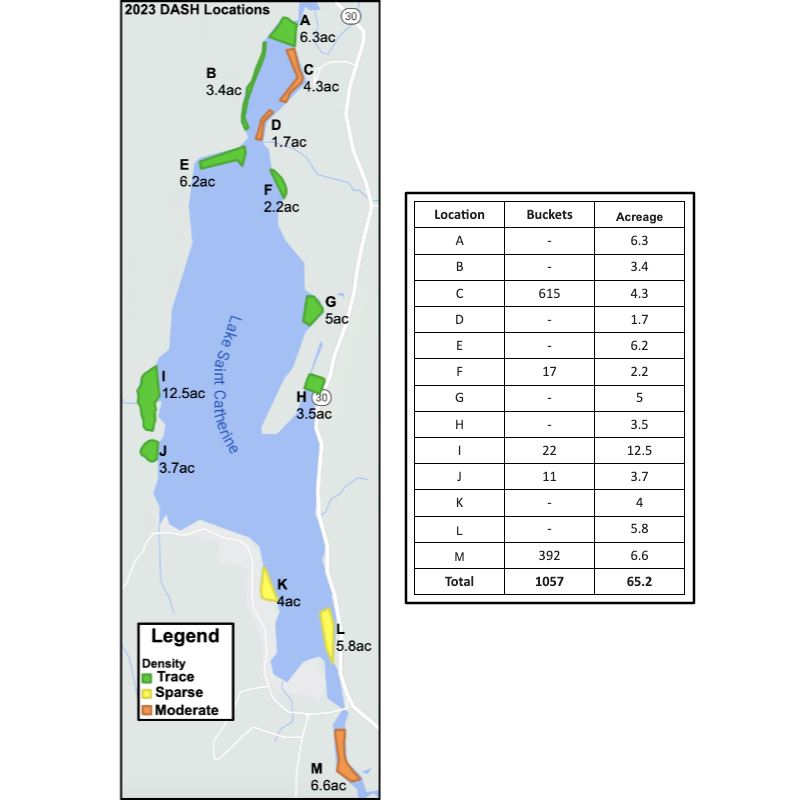The Lake St. Catherine Association would like to thank the Lake Champlain Basin Program (LCBP) and the State of Vermont's Aquatic Nuisance Control (ANC) Grant-In-Aid Program for helping to partially fund important components of our aquatic invasive species (AIS) prevention and control programs which include our newly launched Vermont Invasive Patrollers (VIP) Program, our Greeter Program, and our Diver Assisted Suction Harvesting (DASH) Program.
Vermont Invasive Patrollers (VIP) Program
The VIP program was established by the Department of Environmental Conservation (DEC) in 2007 to focus on early detection of all known and potential aquatic invasive species before they can become established in a waterbody. Early detection is vital to protecting Lake St. Catherine from harmful invasive plants and animals. Volunteers participating in the VIP Program will monitor Lake St. Catherine for new introductions of invasive species and report their findings to the DEC. If a new invasive is discovered, the DEC will dispatch a team and work with the LSCA to organize an effort to remove it from the lake.
In late August, members of the LSCA and 4 volunteers performed the first VIP paddle at the boat launch in Wells. On this first introductory paddle, we used underwater viewers (purchased as part of the LCBP grant) to find and identify many of our native plants, while keeping an eye out for invasive plants or animals around the boat launch. Patrolling the boat launch is a great place to kickoff this program, as it is a high-risk area for aquatic invasive species introduction.
We'll perform more VIP paddles in 2024. We hope you'll join us - it was a lot of fun! If you'd like to learn more about this new program on LSC, please visit the VIP Program page on our website to learn more.
Greeter Program - Boat Launch Monitoring
Our Greeter Program is very important to the health of Lake St. Catherine. Our Greeters have been trained to identify aquatic invasive species - like spiny waterflea, asian clams, water chestnut, starry stonewort and zebra mussels - to stop them from entering LSC at the boat launch in Wells and the State Park in Poultney. They also educate boaters about the importance of looking for these invasives on their boat or trailer so they are not spread to LSC or another lake. Each year, they do a fantastic job checking vessels and educating the lake community on the dangers of invasive species for Lake St. Catherine. They are on duty from Memorial Day through Labor Day - working on Friday, Saturday and Sunday. They also cover holidays and fishing tournaments.
In total, our Greeters inspected 1,149 boats this year at the boat launch in Wells, and at the State Park in Poultney. This is around 800 less than the number of vessels they inspected last year. Boat launches were down in 2023, most likely due to numerous rainy weekends this season.
Milfoil Control Program
Each season, the LSCA implements a Milfoil Control Program to keep milfoil in check in Lake St. Catherine using a combination of spot herbicide treatments and DASH (Diver Assisted Suction Harvesting).
The LSCA’s Milfoil Control Program consists of four components:
1. ‘Stop The Spread’ education and outreach. Our ‘Stop The Spread’ campaign educates boaters and property owners on best practices to limit the spread of milfoil. Each year, the LSCA holds a lake community meeting to discuss the control plan for the season, answer questions, and hand out a flyer with best practices for lake users to limit the spread of milfoil.
2. Volunteer milfoil cleanup. Throughout the season, we organize volunteers to collect detached floating milfoil from the lake and deposit it on our designated drop off platforms. The milfoil is then picked up from the platforms and disposed of. We also encourage boaters and property owners to remove any milfoil they see in the lake while boating or on their shoreline.
3. DASH - Diver Assisted Suction Harvesting. Our DASH crew suits up in scuba gear and hand-pulls milfoil by the roots from the lakebed. In sections of lower milfoil density, they will swim the area and hand-pull with mesh bags. In higher density areas, they will set up the DASH equipment which allows them to suction the hand-pulled milfoil up through a tube to a catch table on a boat. Milfoil is then placed in 17.5 gallon buckets for transport off the lake.
4. Herbicide spot treatments with ProcellaCOR EC. In order to maximize our DASH crew’s time, effectiveness, and number of acres covered, one of our control methods includes spot treatments with the herbicide ProcellaCOR EC (we did not perform a spot treatment in 2023).
Although not directly related to Milfoil Control, the LSCA's work on Lake Wise on LSC, the LSC Stormwater Master Plan, and the LSC Watershed Action Plan all help to limit phosphorus and other nutrients from entering the lake which can contribute to excessive plant growth, and improves overall water quality.
Our DASH crew started their work early in the summer by swimming and hand-pulling milfoil in less dense areas, and began full DASH operations on July 1st, and worked into September. Over this time, the DASH crew removed 1,057 (17.5 gallon) buckets of milfoil from the lake, covering just over 65 acres in 5 areas of the lake.

These vitally important programs for Lake St. Catherine are partially funded through grants earned by the LSCA from the LCBP and the State, with the majority of the funding coming through generous donations and membership dues from the lake community.
THANK YOU to the LCBP, the State, and all those who have contributed to the LSCA this season to help make these programs a success.
